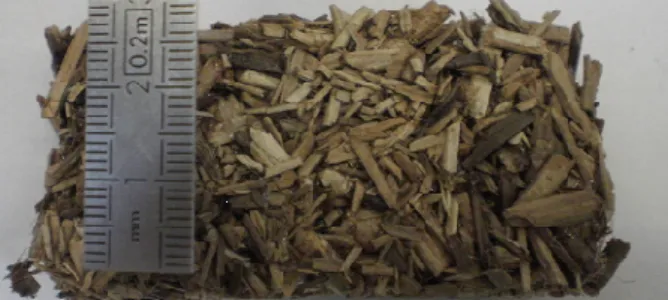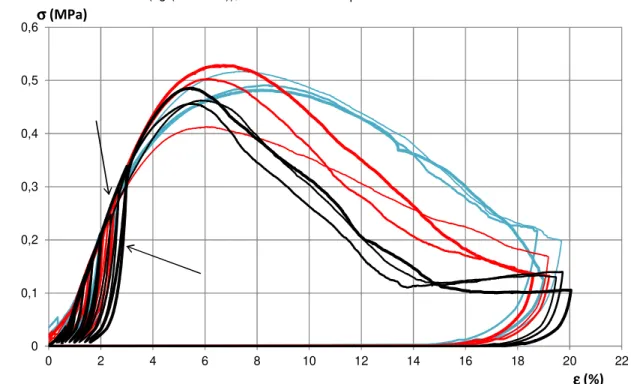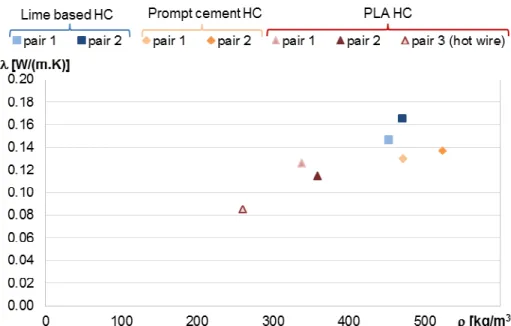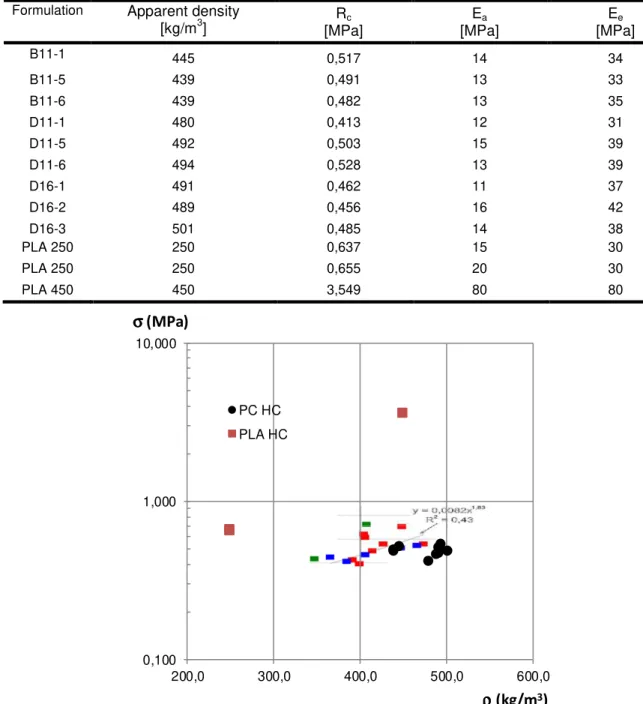First International Conference on Bio-based Building Materials June 22nd - 24th 2015
Clermont-Ferrand, France
COMPARING HEMP COMPOSITES MADE WITH MINERAL OR ORGANIC
BINDER ON THERMAL, HYGRIC AND MECHANICAL POINT OF VIEW.
F. Collet1*, S. Pretot1, B. Mazhoud1, L. Bessette2, C. Lanos1
1 Université de Rennes 1, Laboratoire de Génie Civil et Génie Mécanique – équipe
Matériaux-Thermo-Rhéologie, 35704 Rennes Cedex, France
2 VICAT, 4 Rue Aristide Bergès, Les 3 vallons, 38080 L'Isle d’Abeau, France
*Corresponding author; e-mail: florence.collet@univ-rennes1.fr
Abstract
This study investigates the effect of the kind of binder on thermal, hygric and mechanical properties of hemp composites. Three binders are considered: a formulated hydraulic lime based binder, a prompt cement based binder and a peculiar bio-polymer: the Poly-Lactic Acid (PLA). The binder is coupled with hemp shiv to produce biocomposite. For each kind of binder, the specific manufacturing method is presented and discussed. The thermal properties of produced biocomposite are measured with a hot disk method at 23°C, 50%RH. The hygric characterization is based on the measurement of Moisture Buffer Value at 23°C. The mechanical behavior of composite under compression is analyzed. Thermal conductivities range from 0.08 to 0.16 W/(m.K), this allows to use these composites without added insulation layer. Following the classification given in the Nordtest report, the studied materials are very good or excellent hygric regulator. Performances are slightly higher with mineral binders. However, the compressive strength obtained with PLA binder are much higher than the ones with mineral binders.
Keywords:
Biocomposite, type of binder, thermal properties, moisture buffer value, mechanical strength.
1 INTRODUCTION
Renewable raw materials appear as an answer to the problem of resource depletion. Mixture between vegetal macrofibres and binder allows one to produce building materials [Amziane 2013]. Such lightweight material shows a quite low thermal conductivity (about 100 mW/(m.K)). On hygric point of view, hemp concrete is strongly hygroscopic, with high moisture transfer and storage capacities. These properties allow hemp concrete to moderate ambient relative humidity variations. It is an excellent hygric regulator with moisture buffer values globally higher than 2 g/(m².%RH) [Collet 2013]. On mechanical point of view, hemp concrete is a non-load bearing material. It requires large time before drying and gains mechanical resistances.
Thermal, hygric and mechanical performances of hemp concrete depend, among other factors, on the type of components and on the mix proportioning. The binder used to produce hemp composite is generally mineral binder (mainly a formulated hydraulic lime), it can also be an organic one.
This study investigates the effect of the kind of binder on thermal, hygric and mechanical properties of hemp composites. Three binders are considered: two commonly used mineral binders for housing
construction: a formulated hydraulic lime based binder and a prompt cement based binder; and a peculiar bio-polymer: the Poly-Lactic Acid (PLA). The PLA is currently tested to produce composite materials (automotive industry) from flax or hemp fibers [Le Duigou 2010][Le Duigou 2011]. Up to now, no transposition of this technique to the hemp shiv composite production for building materials is mentioned.
Firstly, this paper details raw materials selection and formulation of hemp composite. Each binder is coupled with a selected hemp shiv to produce specimens with specific manufacturing method: spraying or casting. Usual mix design are used for mineral binders. For PLA binder, various hemp shiv proportions are tested. A specific hot temperature casting method is used to produce specimens with large range of apparent density. Then, experimental procedure are presented. Finally, thermal, hygric and mechanical characteristics are presented and discussed.
2 RAW MATERIALS SELECTION, HEMP COMPOSITES FORMULATIONS AND PRODUCTION
2.1 Binders selection
The first binder is a lime-based binder. This commercial product (Tradical BCB PF70 – BCB France) is commonly used to produce hemp concrete. This binder is a formulated lime composed of air-slake lime (75%), hydraulic lime (15%) and Pozzolane: 10%. Content of surfactants is suspected. The setting time of such binder starts between 3 and 5 h, depending on the water content. Hydration of this lime leads to compression strength ranging between 2 and 15 MPa for water to binder mass ratio (W/B) ranging between 1 and 0.4 respectively. The specific density of hydrated binder is evaluated to 2300 kg/m3.
The second binder is a natural cement. This commercial product (Prompt cement - VICAT France) is commonly used to produce hemp concrete. This cement is a natural hydraulic binder with high content of silica. The setting time of such binder is short, few minutes, and add of retarders is common (use of citric acid). Hydration of this binder leads to compression strength (tests performed on cement paste) ranging between 4 and 20 MPa at 28 days, for water to binder mass ratio (W/B) ranging between 1 and 0.5 respectively. The apparent density of hydrated binder is comprised between 1500 to 2100 kg/m3.
The third binder is a peculiar bio-polymer: the Poly-Lactic Acid (PLA provided by Galactic - Belgium). This polymer is biodegradable and is characterized by very high mechanical properties (flexural strength of 17.8 MPa and compression strength higher than 50 MPa, elastic modulus of 3500 MPa). This thermoplastic material is characterized by a glass transition temperature around 200°C. PLA is marketed in granular form. The specific density of this binder is evaluated to 1240 kg/m3.
2.2 Shiv selection
The shiv is a commercial product (Chanvribat – LCDA France) commonly used to produce hemp concrete. Its bulk density is about 100 to 110 kg/m3. The mean
width of particles (D50) is 2.2 mm and the mean length is 8 mm. The maximal width is 5 mm and the maximal length is 19 mm.
2.3 Hemp composite formulations and production The hemp concrete realized with Tradical BCB PF70 binder is applied with spray technic. The dry mix of binder and shiv is transported by compressed air flow into a pipe. Add of water at the nozzle induces the paste formation gluing the shiv. The proportion of Hemp shiv (HS) remains the same for all formulation with HS/B = 0.5. The water content added to the mixes is the same for all the formulation with a ratio W/B expected at 0,8. The spray technic is used to fill molds. This hemp concrete is quoted Lime Based Hemp Concrete.
The hemp concretes realized with Prompt cement are realized with a concrete mixer. This type of hemp concrete is devoiced to the sheathing method. The proportion of hemp shiv is quite the same as in the previous case with HS/B = 0.4. The water content added to the mixes is the same for all the formulation with a ratio W/B of 0.96. Hemp shiv and binder are mix together in the mixer for 2 minutes. Then Water is added progressively at low rotation speed until homogeneity of mix (around 3 minutes). The hemp concrete is then poured in cylindrical molds (16 cm diameter and 32 cm height or 11 cm diameter and 22 cm height) in six layers. Each layers is compacted with constant loading (0.05 MPa as proposed by [CenC
2007]). This hemp concrete is quoted Prompt Cement Hemp Concrete.
In the case of mineral binders, molds are covered and place in curing room for one week. The molds are removed and natural drying of hemp concrete blocks is started. The blocks stay in climatic room (23°C, RH 50%) and their mass evolution is recorded. After mass stabilization, some specimens are used for physical and thermal analysis. Other specimens are devoiced to mechanical tests.
In the case of PLA binder, a dry mix of shiv and PLA is placed in the metallic closed molds. The molds are placed in an oven for PLA softening and to assure the gluing of shiv (figure 1). After natural cooling, specimens are removed of molds. Two type of proportion HS/B are used: 1 and 0.5, inducing different values of specimens density (between 250 and 500 kg/m3). Prismatic molds are used to produce specimens for mechanical tests. Cylindrical molds are used to produce specimens for physical and thermal characterizations. This hemp composite is quoted PLA Hemp Composite.
The specimen sizes differ between studied materials but this do not impact the thermal and hydric characterizations which depend on probing depth only. Few influences are expected on mechanical results.
Fig. 1: PLA Hemp Composite specimen. 3 EXPERIMENTAL PROCEDURES 3.1 Thermal characterization
The thermal properties are measured at 23°C, 50%RH. In order to limit water migration during the test, the measure is performed with a transient plane source (TPS). The Hot Disk allows measuring both thermal conductivity and thermal diffusivity simultaneously. The commercial device is a Hot disk TPS 1500 (from Thermoconcept) equipped with a hot disk Ref.4922. The outer radius of the double-spiral heater is 14.61 mm (figure 2). The measure is performed with the sensor sandwiched between two specimens. The Hot Disk is both the heat source and the temperature sensor. The contact surface of specimens is as flat as possible in order to ensure the thinner air layer between specimens. According to the manufacturer, the contact resistance between sensor and specimens does not influence measurement results. The Hot disk TPS 1500 is well adapted for the measurement of thermal conductivities ranging from 0.01 to 400 W/(m.K) and thermal diffusivity ranging from 0.1 to 100 mm²/s. The expected accuracy is better than 5%. For the thermal characterization of hemp composites, specimens are firstly dried and then stabilized to (23°C; 50%RH) in a climatic chamber. The measurement are also performed at (23°C; 50%RH) in a climatic chamber. For each material, two pairs of specimens are used and three measurements are performed on each pair.
Fig. 2: Hot Disk Sensor Ref 4922
The volumic heat and the specific heat capacity are then calculated from thermal conductivity, thermal diffusivity and density.
3.2 Hygric characterization
The hygric characterization is based on the measurement of the moisture buffer value of materials which characterizes their ability to moderate the variations of indoor humidity in buildings.
The moisture buffer value is measured following the Nordtest protocol Rode 2005]. Specimen are sealed on all but one surfaces. After stabilization at (23°C; 50%RH), they are exposed to daily cyclic variation of ambient relative humidity (8 hours at 75%RH and 16 hours at 33 %RH) in a climatic chamber (Vötsch VC4060). The moisture buffer value is thus calculated from their moisture uptake and release with:
(2)
Where:
MBV : Moisture Buffer Value (kg/(m².%RH)),
∆m : moisture uptake / release during the period (kg), A : open surface area (m²),
RHhigh / RHlow : high/low relative humidity level (%).
During the test, temperature and relative humidity are measured continuously with Sensirion SHT75 sensors and with the sensor of the climatic chamber. The specimens are weighed out of the climatic chamber five times during the absorption period and two times during the desorption period. The weighing instrument reading is 0.01 g, and its linearity is 0.01 g. According to the NORDTEST protocol, stability is reached when the change in mass is the same between the last three cycles with a discrepancy of less than 5 % [Roels 2005]. In this study, specimen are dried at 60°C before being stabilized to (23°C; 50%RH).
3.3 Mechanical characterization
Mechanical tests are realized with a universal machine (Instron®) of capacity 400 kN controlled in displacement (cyclic loading) with a data recording at 0.10 Hz. Mechanical tests are done onto various sizes of specimens:
- Blocks 15x30x30 cm3 for lime based HC. - Cylindrical specimens for Prompt Cement HC. - Small 4x4x16 cm3 for PLA HC.
In all case, the mechanical behavior of hemp concrete is characterized by large post pick plastic domain as presented on figure 3 (case of Prompt Cement Hemp Concrete). Cyclic loading permits the analysis of the effect of loading and unloading on elastic behavior. Apparent modulus Ea and elastic modulus Ee are then
distinguished. Maximum compressive strength Rc and
associated strain are quoted. For large strain, the residual strength level remains high for all testes hemp composites. 0 0,1 0,2 0,3 0,4 0,5 0,6 0 2 4 6 8 10 12 14 16 18 20 22
σ
σ
σ
σ (MPa)
εεεε (%)
Fig. 3: Examples of strain-stress curves obtained with Prompt Cement Hemp Concrete. 4 RESULTS
4.1 Thermal characteristics
Figure 4 gives the thermal conductivity of studied hemp composites versus density at (23°C; 50%RH). Thermal conductivity globally increases with density.
The PLA HC shows the lowest values of thermal conductivity ranging from 0.085 W/(m.K) at 260 kg/m3
to 0.120 W/(m.K) at 350 kg/m3. The lime based HC
shows the highest values of thermal conductivity: around 0.156 W/(m.K) at 460 kg/m3. The prompt
cement HC, with similar density as lime based HC, shows lower thermal conductivity (0.134 W/(m.K) at
500 kg/m3). The thermal conductivity is thus dependent on density and is also impacted by the type of binder. Figure 5 gives the specific capacity of hemp composites versus density at (23°C; 50%RH). The values are very close for the three hemp composites with average values equal to 1161 J/(kg.K) for lime based HC, to 1033 J/(kg.K) for prompt cement HC, and
to 1156 J/(kg.K) for PLA HC. Combined with density, such specific heat capacity leads to higher heat storage in lime based HC and in prompt cement HC than in PLA HC for the same volume of material. Lime based HC and prompt cement HC would thus show higher thermal inertia.
Fig. 4 : Thermal conductivity of hemp composites versus density at (23°C; 50%RH)
Fig. 5 : Specific heat capacity of hemp composites versus density at (23°C; 50%RH) .
4.2 Hygric characteristics
Figure 6 shows the ambient relative humidity in the climatic chamber during the test. The peaks on the curve are due to the door opening for the weighing of specimens. The setpoint is well maintained as the average value of relative humidity (RH) is 73.4 %RH during absorption (slightly lower than 75 %) and 32.6 % RH during desorption (slightly lower than 33%). The step changes in relative humidity are achieved within 30 minutes as well from low to high RH as from high to low RH. This induces a nearly square wave of relative humidity.
For all composites, the results are similar for all specimen. Figure 6 gives an example of the variation of mass of one specimen of prompt cement composite. The declining tendency of the mass is due to the initial conditions where, after drying, the specimens are stabilized to 23°C 50%RH and then exposed to 75% RH. This conditions are higher than the average of the quasi steady state conditions that arise after some cycles. As shown figure 6, the cyclic amounts of moisture uptake and release are approaching each other and the change in moisture buffer value is less than 5 % within each cycle from the third cycle. The moisture buffer value is thus calculated from cycles 3 to 5.
Fig. 6 : Relative Humidity and example of moisture uptake and release during the test (specimen of prompt cement composite)
Figure 7 gives the moisture buffer value of hemp composites versus density.
For all composites, the measures performed on the four specimens give similar results for moisture uptake and release; and thus for Moisture Buffer Value. The cyclic amounts of moisture uptake and release are approaching each other and the change in moisture buffer value is less than 5 % within each cycle from the third cycle. The moisture buffer value is thus calculated from cycles 3 to 5.
The average Moisture Buffer Values range from 1.77 g/(m².%RH) for PLA HC to 2.17 g/(m².%RH) for prompt cement HC. It is equal to 1.92 g/(m².%RH) for lime based composites. According to the NORDTEST project classification, the moisture buffering capacity of these composites is thus good (1<MBV<2 g/(m².%RH)) or excellent (MBV > 2 g/(m².%RH)).
The MBV of lime based composite is slightly lower than values met in literature [Collet 2013]. This is due to the initial moisture state of the composite. Actually, in this study, composites were previously dried, before being stabilized to (23°C; 50%RH). It was shown in literature that the initial moisture state impacts the MBV of materials [Osanyintola 2006].
The moisture buffer value results both from mass transfer and storage capacities of materials. The PLA HC, with the lowest density, would show the highest moisture transfer capacity. However, the specific surface area developed in prompt cement matrix would lead to higher moisture buffering capacity, due to higher storage capacity.
4.3 Mechanical characteristics
Mechanical parameters measured from mechanical tests are presented in table 1. After hardening and drying, the Lime based hemp concrete present compressive strength largely influenced by density (figure 4). The level of compressive strength remains lower than 0,8 MPa for densities ranging between 350 and 500 kg/M3. Results of compressive strengths are noisy. Mechanical tests are realized on full blocks or alf blocks compressed vertically or horizontally. No influences of specimen size and compression direction are highlighted.
Fig. 7 : Moisture Buffer Value versus density of hemp composites – average value and standard deviation. The compressive strengths obtained on Prompt Cement HC specimens are placed on figure 4 too. For the same densities the performances are quite equivalent for the two mineral binders hemp concretes. The curves strain-stress presented in figure 3 correspond to tests realizes on two size of cylindrical specimens. Quite no effect of specimen size is detected. The compressive strength obtained for PLA HC are added on figure 4. For the same density, such hemp composites present compressive strengths six time higher than other hemp concretes.The ductility of hemp concrete obtained with Prompt cement (figure 3) is higher than those of lime binder HC. But the best ductility is obtained with PLA hemp composite (fig. 9). The obtained curves present large plastic behavior with quite plateau value until large strains.
The values of apparent and elastic modulus of Prompt Cement HC and PLA HC appear quite similar, showing the low influence of the binder type on this properties.
Tab. 1: Average mechanical parameters obtained on hemp concretes specimens, conservation at 23°C; 50RH. 0,100 1,000 10,000 200,0 300,0 400,0 500,0 600,0 PC HC PLA HC
σ
σ
σ
σ (MPa)
ρ
ρ
ρ
ρ (kg/m
3)
Fig. 8: Compressive strength of tested hemp composites versus density. Data of Lime Based HC from [Glouannec 2011] are superimposed.
0 0,5 1 1,5 2 2,5 3 3,5 4 0 0,02 0,04 0,06 0,08 0,1 0,12 0,14 0,16 PLA HC 450 PLA HC 250 PLA HC 250 σ σ σ σ (MPa) εεεε (m/m) Fig. 9: Strain-stress curves obtained with PLA Hemp composites. Formulation Apparent density
[kg/m3] [MPa] Rc [MPa] Ea [MPa] Ee
B11-1 445 0,517 14 34 B11-5 439 0,491 13 33 B11-6 439 0,482 13 35 D11-1 480 0,413 12 31 D11-5 492 0,503 15 39 D11-6 494 0,528 13 39 D16-1 491 0,462 11 37 D16-2 489 0,456 16 42 D16-3 501 0,485 14 38 PLA 250 250 0,637 15 30 PLA 250 250 0,655 20 30 PLA 450 450 3,549 80 80
5 CONCLUSIONS
This paper relates the effect of binder composition on, thermal, hygric and mechanical properties of hemp composites.
Thermal conductivities range from 0.08 to 0.16 W/(m.K), this allows to use these composites without added insulation layer. Following the classification given in the Nordtest report, the studied composites are very good or excellent hygric regulator.
Mineral binders lead to the best hygric performance on moisture buffering point of view. Despite very different manufacturing method (spraying and casting), the two studied solutions appear quite equivalent.
According to the obtained compressive strength, the composites produced with mineral binders are non load bearing materials. Such constructive solutions imposed the use of a framework.
The use of PLA binder may allow to develop building materials with the best compromise between density, thermal conductivity, hygric properties and mechanical properties. The PLA binder allow producing partially load bearing composite. This mechanical performance must be confirmed by additional tests performed on specimen with standard sizes. Performances are quite equivalent to those of cellular concrete. But, this constructive solution should to be rigorously evaluated. PLA is biodegradable polymer. Then, long exposure to water, ageing under radiation, can be problems. More, the viscosity of the PLA is high, even in hot condition, and its use and mix with hemp shiv is made difficult. A specific process is thus needed and seems to be necessarily pre casting.
The future developments and roles of such bio-sourced materials are obvious. These developments must also take into account their fire resistance and their durability.
6 REFERENCES
[Amziane 2013] Amziane, S.; Arnaud, L.; Bio-aggregate-based Building Materials, Applications to Hemp Concrete. ISTE Ltd and John Wiley & Sons, Inc, 2013.
[CenC 2007] (2007) Règles professionnelles d’exécution d’ouvrage en bétons de chanvre, Association Construire en chanvre, (révision 2011). [Collet 2013] Collet, F.; Chamoin, J.; Prétot, S.; Lanos, C.; Comparison of the hygric behaviour of three hemp concretes, Energy and Buildings, 2013, 62, pp 294-303.
[Osanyintola 2006] Osanyintola, O., F.; Talukdar, P.; Simonson, C.; Effect of initial conditions, boundary conditions and thickness on the moisture buffering capacity of spruce plywood. Energy Build 2006;38:1283e92.
[Rode 2005] Rode, C.; Moisture buffering of Building Materials, Report BYG•DTU R-126, ISSN 1601 – 2917, ISBN 87-7877-195, 2005.
[Roels 2005] Roels, S; Janssen, H.; Is the moisture buffer value a reliable material property to characterize the hygric buffering capacities of building materials? Working paper A41-T2-B-05-7 for IEA Annex 41 project. Whole Building Heat. Air and Moisture Response, Trondheim, 2005.
[Le Duigou 2010] Le Duigou, A., P. Davies, and C. Baley, Interfacial bonding of flax/Poly(L-Lactide) biocomposites. Composites Science and Technology, 2010. 70(2): p. 231-239.
[Le Duigou 2011] Le Duigou, A., P. Davies , and C. Baley, Environmental impact analysis of the production of flax fibres to be used as composite material reinforcement. J. biobased. mater.bioenerg., 2011. 5: p. 1-13.
[Glouannec 2011] Glouannec P. ; Collet, F. ; Lanos C. ; Mounanga P. ; Pierre T. ; Poullain P. ; Pretot S. ; Propriétés physiques de bétons de chanvre ; Matériaux & Techniques, Volume 99, Number 6, p.657-665, 2011.




